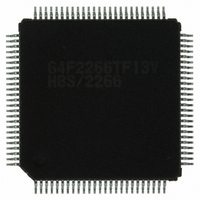DF2266TF13V Renesas Electronics America, DF2266TF13V Datasheet - Page 99

DF2266TF13V
Manufacturer Part Number
DF2266TF13V
Description
IC H8S/2266 MCU FLASH 100-TQFP
Manufacturer
Renesas Electronics America
Series
H8® H8S/2200r
Datasheet
1.DF2266TF20V.pdf
(712 pages)
Specifications of DF2266TF13V
Core Processor
H8S/2000
Core Size
16-Bit
Speed
13MHz
Connectivity
I²C, SCI, SmartCard
Peripherals
LCD, POR, PWM, WDT
Number Of I /o
67
Program Memory Size
128KB (128K x 8)
Program Memory Type
FLASH
Ram Size
8K x 8
Voltage - Supply (vcc/vdd)
3 V ~ 5.5 V
Data Converters
A/D 10x10b
Oscillator Type
Internal
Operating Temperature
-20°C ~ 75°C
Package / Case
100-TQFP, 100-VQFP
Lead Free Status / RoHS Status
Lead free / RoHS Compliant
Eeprom Size
-
- Current page: 99 of 712
- Download datasheet (5Mb)
2.8
The H8S/2000 CPU has five main processing states: the reset state, exception handling state,
program execution state, bus-released state, and power-down state. Figure 2.13 indicates the state
transitions.
• Reset State
• Exception-Handling State
• Program Execution State
• Bus-Released State (H8S/2268 Group only)
• Power-down State
In this state, the CPU and all on-chip peripheral modules are initialized and not operating.
When the RES input goes low, all current processing stops and the CPU enters the reset state.
All interrupts are masked in the reset state. Reset exception handling starts when the RES
signal changes from low to high. For details, refer to section 4, Exception Handling.
The reset state can also be entered by a watchdog timer overflow.
The exception-handling state is a transient state that occurs when the CPU alters the normal
processing flow due to an exception source, such as a reset, trace, interrupt, or trap instruction.
The CPU fetches a start address (vector) from the exception vector table and branches to that
address. For further details, refer to section 4, Exception Handling.
In this state, the CPU executes program instructions in sequence.
In a product which has a bus master other than the CPU, such as a data transfer controller
(DTC), the bus-released state occurs when the bus has been released in response to a bus
request from a bus master other than the CPU.
While the bus is released, the CPU halts operations.
This is a power-down state in which the CPU stops operating. The program stop state occurs
when a SLEEP instruction is executed or the CPU enters hardware standby mode. For further
details, refer to section 22, Power-Down Modes.
Processing States
Rev. 5.00 Sep. 01, 2009 Page 47 of 656
REJ09B0071-0500
Section 2 CPU
Related parts for DF2266TF13V
Image
Part Number
Description
Manufacturer
Datasheet
Request
R

Part Number:
Description:
CONN SOCKET 2POS 7.92MM WHITE
Manufacturer:
Hirose Electric Co Ltd
Datasheet:

Part Number:
Description:
CONN SOCKET 4POS 7.92MM WHITE
Manufacturer:
Hirose Electric Co Ltd
Datasheet:

Part Number:
Description:
CONN SOCKET 5POS 7.92MM WHITE
Manufacturer:
Hirose Electric Co Ltd
Datasheet:

Part Number:
Description:
CONN SOCKET 3POS 7.92MM WHITE
Manufacturer:
Hirose Electric Co Ltd
Datasheet:

Part Number:
Description:
CONN SOCKET 5POS 7.92MM WHITE
Manufacturer:
Hirose Electric Co Ltd
Datasheet:

Part Number:
Description:
CONN SOCKET 2POS 7.92MM WHITE
Manufacturer:
Hirose Electric Co Ltd
Datasheet:

Part Number:
Description:
CONN SOCKET 3POS 7.92MM WHITE
Manufacturer:
Hirose Electric Co Ltd
Datasheet:

Part Number:
Description:
CONN SOCKET 4POS 7.92MM WHITE
Manufacturer:
Hirose Electric Co Ltd
Datasheet:

Part Number:
Description:
CONN HEADER 2POS 7.92MM R/A TIN
Manufacturer:
Hirose Electric Co Ltd
Datasheet:

Part Number:
Description:
CONN HEADER 4POS 7.92MM R/A TIN
Manufacturer:
Hirose Electric Co Ltd
Datasheet:

Part Number:
Description:
KIT STARTER FOR M16C/29
Manufacturer:
Renesas Electronics America
Datasheet:

Part Number:
Description:
KIT STARTER FOR R8C/2D
Manufacturer:
Renesas Electronics America
Datasheet:

Part Number:
Description:
R0K33062P STARTER KIT
Manufacturer:
Renesas Electronics America
Datasheet:

Part Number:
Description:
KIT STARTER FOR R8C/23 E8A
Manufacturer:
Renesas Electronics America
Datasheet:

Part Number:
Description:
KIT STARTER FOR R8C/25
Manufacturer:
Renesas Electronics America
Datasheet:










